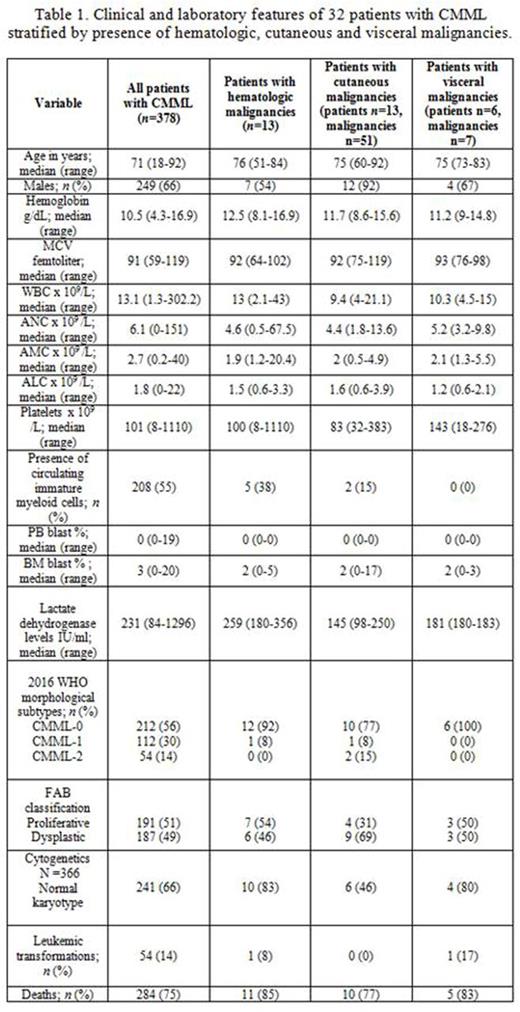Abstract

Background: An increased incidence of second skin and visceral malignancies in comparison to the general population has been reported in patients with hematologic neoplasms such as, chronic lymhocytic leukemia (CLL) (~11-36%) (Tsimberidou, JCO, 2009),chronic myeloid leukemia (CML) (4-6%) (Miranda, Leukemia 2016)and multiple myeloma (MM) (3-4.3%) (Palumbo, Lancet Oncol 2014).Diverse etiologies exist for this association. We carried out this study to describe the spectrum of second malignancies in patients with chronic myelomonocytic leukemia (CMML).
Methods: Patients with World Health Organization defined CMML were included in the study. All patients had bone marrow (BM) biopsies performed at diagnosis. We only included malignancies that were diagnosed at the time of CMML diagnosis or subsequent to it. Patients that had concomitant systemic mastocytosis (n=18), therapy related CMML (n=19) and those that underwent allogeneic stem cell transplantation (n=23) were excluded. Standard cancer specific diagnostic and staging methods were utilized.
Results:The study included 378 patients (median age 71 years; 66% males). Seventy-one concomitant and/or subsequent second malignancies were identified in thirty-two (8%) patients. Age group distribution was; 50-59 years 1 (1%), 60-69 years 21 (30%), 70-79 years 30 (42%) and ≥ 80 years 19 (27%) second malignancies. 22 (69%) patients had 1 second malignancy, 4 (13%) had 2, 2 (6%) had 4 (skin neoplasms), while 4 (13%) patients had ≥ 5 second malignancies (Table one). At a median follow-up of 18 months, 284 (75%) deaths and 54 (14%) leukemic transformations were documented.
i) Second hematological malignancies:
Thirteen (18%) concomitant (n=7, 54%) and subsequent hematological malignancies (n=6, 46%) were observed in 13 (3.5%) patients. In addition, 10 (3%) pre malignant states including, 7 patients with MGUS and 3 with monoclonal B-cell lymphocytosis (MBL) were seen. In one case each, the MGUS and MBL evolved into multiple myeloma (after 16 months) and CLL (after 30 months), respectively. Concomitant malignancies included: polycythemia vera (n=2, 15%), MM (n=2, 15%), marginal zone B-cell lymphoma (n=1, 8%), splenic lymphoma (n=1, 8%), ALK-rearranged T-cell lymphoma (n=1, 8%), while subsequent malignancies included: MM (n=1, 8%), diffuse large B-cell lymphoma (n=1, 8%), Waldenström's macroglobulinemia (n=1, 8%), CLL (n=2, 15%) and acute lymphoblastic leukemia (n=1, 8%). Four (31%) patients needed chemotherapy, with outcomes including: complete remission in one case (multiple myeloma), progression of disease in 2 (multiple myeloma and diffuse large B cell-lymphoma) and partial response in 1 case (ALK rearranged T cell lymphoma). CMML related cytopenias did not preclude patients from getting chemotherapy. Three patients died from causes related to their second malignancies.
ii) Cutaneous malignancies:
Fifty-one (71%) concomitant (n=12, 24%) and subsequent cutaneous malignancies (n=39, 76%) were seen in 13 (3%) patients. The concomitant malignancies included: 7 (14%) basal cell carcinoma (BCC), 5 (10%) squamous cell carcinoma (SCC), while subsequent cancers included: 3 (6%) malignant melanoma, 7 (14%) BCC and 29 (57%) SCC. Four cases (8%) were locally advanced and four patients (8%) had recurrent lesions. A concomitant diagnosis of BCC and SCC was made in 8 patients (16%). All patients were treated surgically or with electrodesiccation and curettage. No deaths or metastases were reported.
iii) Visceral malignancies:
Seven (10%) subsequent visceral malignancies were seen in 6 (1%) patients. These included; colonic adenocarcinoma (n=2, 29%), bladder adenocarcinoma (n=1, 14%), endometrial adenocarcinoma (n=1, 14%), prostate adenocarcinoma (n=1, 14%), clear cell renal carcinoma (n=1, 14%) and papillary thyroid carcinoma (n=1, 14%). All the cases were localized and surgically resected, with two patients (colonic and endometrial adenocarcinoma) needing adjuvant chemo-radiotherapy. All patients achieved complete remission with no mortality related to second malignancies.
Conclusions: Approximately 8% of CMML patients have second cutaneous (3.5%), hematological (3.5%) and visceral (1%) malignancies, with most of these occurring in and beyond the seventh decade (~70%) of life. Mortality related to second cancers was low (2%), with most patients receiving appropriate surgical and adjuvant chemo-radiation therapy.
Al-Kali:Celgene: Research Funding; Onconova Therapeutics, Inc.: Research Funding.
Author notes
Asterisk with author names denotes non-ASH members.

This icon denotes a clinically relevant abstract


This feature is available to Subscribers Only
Sign In or Create an Account Close Modal